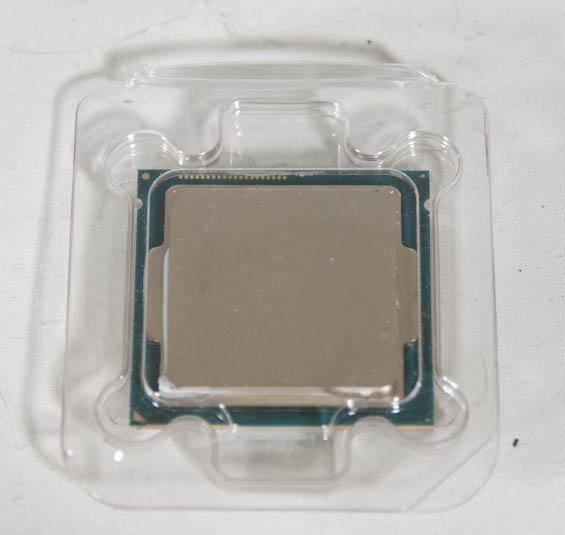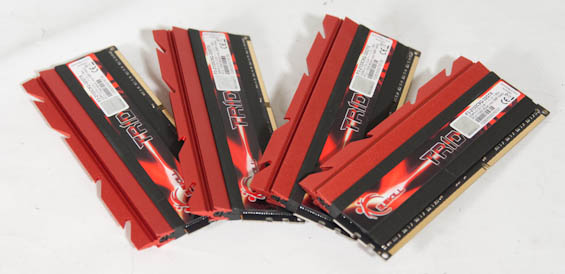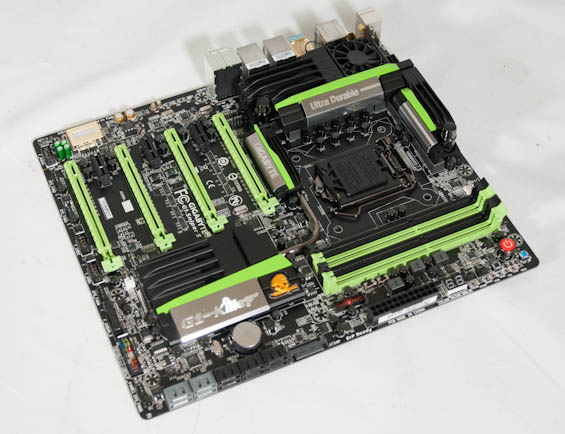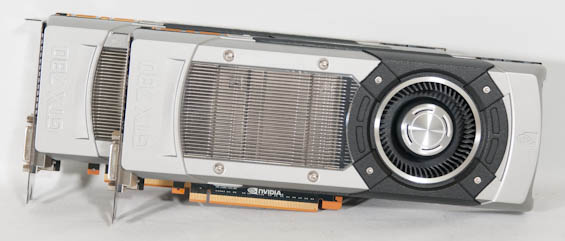The Neophyte's Custom Liquid Cooling Guide: How To, Why To, What To Expect
by Dustin Sklavos on September 30, 2013 12:01 AM ESTComponent selection for this build was tricky, but not overly so. If you're going to engage in an undertaking like this, you really do want to pick the most ideal hardware you can. Thankfully we had a few vendors willing to step up and donate some very high quality kit to this build.
Intel Core i7-4770K Processor

For our CPU we went with Intel's shiny new Haswell architecture in the form of the Core i7-4770K. This quad-core, hyper-threaded chip runs at a nominal 3.5GHz clock with a maximum turbo boost of 3.9GHz on a single core, and is one of Intel's first chips to feature an integrated VRM. Intel's 22nm chips seem to have been largely thermally limited, making the newest member of the family a compelling choice to be the center of a watercooling build. You do always run the risk of getting a dud CPU that simply doesn't want to run at a high clock speed without an unrealistic amount of voltage, though. Note that ours is a retail chip and not an Engineering Sample, so it's subject to the same potential limitations as any CPU you might pick up off the shelf.
Our thanks to CyberPowerPC for graciously donating this processor.
G.Skill Trident X 32GB (4x8GB) DDR3-2133 RAM

Our resident motherboard reviewer and overclocking expert, the good Dr. Ian Cutress, recommended we go with G.Skill for this build, and G.Skill was happy to oblige with a respectable kit of fast DDR3. This kit runs at a nominal 1600MHz, but features an XMP profile that sets it to run at 2133MHz with a CAS Latency of 9 at 1.6V. I'm not an aggressive memory overclocker, which makes the ready-out-of-the-box 2133MHz settings an easy way to score a little extra performance.
Our thanks to G.Skill for providing this memory.
Gigabyte G1.Sniper 5 Z87 Motherboard

I remain of the opinion that the Z87 chipset is arguably the most compelling part of Haswell, and Gigabyte's high end gaming offering hammers that home. The G1.Sniper 5 features a PLX switch enabling full PCIe 3.0 x16 lanes for each of two video cards, or PCIe 3.0 x8 for up to four. Alongside that are an additional four SATA 6Gbps ports to go along with the six that come with the Z87 chipset, dual gigabit ethernet NICs with one provided by Intel and the other courtesy of Killer Networks, and Creative Sound Core3D with a user upgradeable OP-AMP. There's even an 802.11n dual-band PCIe x1 wireless network adapter bundled with the motherboard.
But what sells this board for our purposes is that it includes not only active cooling on the motherboard's 16-phase power circuitry, but a liquid cooling path built in. There are barbs on both ends of the heatsink that allow you to include the power circuitry in your watercooling loop.
Our thanks to Gigabyte for providing this motherboard.
Dual NVIDIA GeForce GTX 780 Graphics Cards

With AMD currently still having issues with multi-GPU surround performance, we were left going to NVIDIA for a pair of high end graphics cards. Two GeForce GTX 770s would've been stellar on their own, but the 780 is getting a healthy reputation as being a decent overclocker in addition to just being a tremendously powerful card on its own. 7.1 billion transistors and 2,304 CUDA cores are nothing to sneeze at, and the 384-bit memory bus connected to 3GB of GDDR5 running at 6GHz stock ensures that beefy engine stays fed.
The biggest shame about using these reference 780s is actually having to remove their stock coolers. NVIDIA did a fantastic job engineering these shrouds, which are both very beautiful and very efficient.
Our thanks to NVIDIA for providing this pair of graphics cards.










106 Comments
View All Comments
Sadrak85 - Monday, September 30, 2013 - link
And one more thing is the addition of onboard voltage regulation, which is a lossy process almost by definition. Meaning, even with the better TIM, I seriously have my doubts that the thermals could hit the level of IVB or SB. Unless Intel somehow has some magic way of using the voltage and amperage they're scrubbing off.*small note, a good motherboard input, in terms of electricity, would pass through the filters pretty cleanly, but because Intel sets the specifications for the input, I have my doubts that they require such a thing, since the feature they added to their chip was to save money for the motherboard vendor.
leafonwind - Monday, September 30, 2013 - link
The thermal interface material is minor compared to the interface distance. Thermal resistance is L/kA. Going from a millimeter of thermal paste to an 10 micron gap (typical of paste when applied correctly) will give a 50x improvement. The difference in k between a good thermal paste and a bad thermal paste is typically a 5x difference unless you get into exotic materials like cadmium. http://forums.anandtech.com/showthread.php?t=22618...gandergray - Tuesday, October 1, 2013 - link
To bolster Von's point, see the work performed by Idontcare: http://forums.anandtech.com/showpost.php?p=3405318... .merikafyeah - Monday, September 30, 2013 - link
Super tiny correction: While it is true that liquids draw away heat much better than air, one must be cautious not to mistake water as a good CONDUCTOR of heat, aka something that "transfers" heat very well. Water is in fact an INSULATOR of heat, aka something that "absorbs" heat very well.merikafyeah - Monday, September 30, 2013 - link
Note wording on first page, third paragraph.ShieTar - Monday, September 30, 2013 - link
Correct, but to be precise, neither air nor water will conduct heat quickly enough for PC cooling purposes, both are only used to absorb the heat before being transported away from the heat source.Which makes you wonder how a closed-loop, compressed air cooling system would fare against a water-cooling system. Heat capacity might still be lower for air than for water, even at increased pressures, but I assume that you can produce higher flow rates for a compressed gas than for a liquid. And you could use the required compressor in order to:
1) Reduce the air temperature below room temperature before sending it to the heat sources.
2) Increase radiator temperature over the CPU/GPU temperatures, thus achieving the same heat transfer with lower air flow rates through the radiator. Though temperatures above 100°C may be unsafe in a consumer device for several reasons.
Does anybody know if such a system has been considered and tested anywhere?
Death666Angel - Monday, September 30, 2013 - link
Considered? Probably. Used? Not to my knowledge. If you have a compressor it makes more sense to cool the water used in the loop to just above freezing or even below freezing with the right additives. Of course, if you cool it that much, you have to worry about condensation, so most people I read about who use compressor cooling for their liquid (instead of large radiators) keep the water around room temperature and have the cooler in another room, to not be bothered by the noise.The stuff that is used to conduct heat away from the components inside the PC is the metal heatsink. In the case of pure air cooling you then push air through the metal heatsink fins. Because of the delta T you have the air warming up, the metal cooling and being able to absorb heat from the CPU/GPU etc. again. In case of water cooling, you have the water running through the heatsink (usually some very fine canals inside that increase surface and flow rate) which absorbs the heat from the heatsink and gets transported to (large) radiators where air is again pushed/pulled through the radiator fins in order to cool it.
Sadrak85 - Monday, September 30, 2013 - link
Used all the time; Nitrogen is the most common component of air; it is compressed so much as to become a liquid. Then, thanks to the Carnot cycle, cooling the liquid to room temperature results in it boiling and becoming ultra-cold air, which cools a processor.A similar thing happens with your refrigerator.
These coolers, however, require massive power to get them to that level, so they're only really useful for very niche-applications, but the equipment isn't really that hard to find. An evaporator will cost you something like $200 to $300, and then the Nitrogen.
Now, if you're talking about keeping the air gaseous, then what you'll find is it just isn't possible. Cooling it very much with pressure on it will result in it condensing to liquid. If you just compress it, without the cooling, you'll heat it up, of course, which is how your diesel engine works.
ShieTar - Monday, September 30, 2013 - link
Fair enough. I am fully aware of the cooling concept via liquid nitrogen boiling itself, but I was considering a much simpler concept. Maybe I should describe it in a bit more detail.Imagine a closed air (or just nitrogen) system where the air pressure is about 3 bar within a radiator and about 2 bar when it circulates within the cooling blocks. You can have temperatures around 200K at 2 bar without liquifying, and not that much higher at 3 bar.
So you offer your GPU/CPU coolers 2bars of air at 200K, maybe heat it to 220K, compress it to 3bar/330K, cool it back down to 300K (close to room temperature), decompress back to 2bar/200K.
What needs a little more math is, just how much volume of gas do I need for this to transport 600W or so of power by this concept. And how much additional energy do I waste on the compression process. And probably, just how horribly noisy will this setup get with 2bars of air at high velocities getting pressed through the cooling blocks at high velocities.
Yeah, the more I think about it, the worse the whole concept sounds. Nevermind it.
UltraWide - Monday, September 30, 2013 - link
Excellent article, I enjoyed reading this journey into water cooling. Keep up the great work!